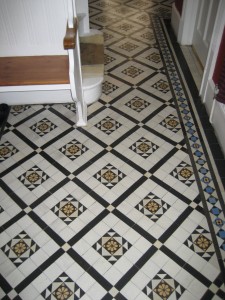The use of ceramic tiles is another distinctive feature of Edwardian suburban housing. They were used in kitchens and in bathrooms (which were becoming a standard feature of all but the smallest houses), as they are today, but in many cases the original tiles in these parts of the house have been replaced over time. In the twenty first century, original tiles and designs are more likely to be found in halls, porches and garden paths.
As with coloured and leaded glass, the appeal of tiles to the builders and inhabitants of Edwardian Palmers Green would have been both practical and aesthetic. Household cleanliness was one of the defining virtues, and the environment of Edwardian Palmers Green must have posed a constant challenge to the inhabitants of the new houses springing up on either side of Green Lanes, as they strove to keep their new homes clean and tidy. The new roads being carved out of the local estates and farms would have been dusty in summer, wet and muddy in winter. The first new motor-cars still shared those roads with horses and carts. The sheer scale and duration of building work – not just houses, but shops, public buildings and churches, as well as the excavations needed to install drains and utilities – would have added to the challenge of keeping paths and hallways respectable.
The answer lay in tiles – smart, modern and attractive, but hard-wearing and easy to clean. They had been widely used in Victorian times, and remained standard for entrance-spaces in even small Edwardian houses. As with other types of decorative fitting, the trend by this point was for designs that were simpler than previously – but given the exuberance of Victorian taste, this still left plenty of scope for display.

In comparison to Edwardian housing elsewhere in Britain, builders in London tended to favour a relatively simple palette of colours. Geometric patterns of tessellated black and white tiles were standard for external paths, and also the most common choice for hall floors. But the patterns were often impressively complex – an up-to-date tessellated hall floor was a selling point in a new house, providing a striking entrance to impress visitors – and would need careful design and skilled installation. The use of more expensive coloured tiles, and encaustics (which were manufactured in stages to provide a pattern within the tile), provided more scope for elaboration. A handbook on the use of tiles published in 1904 suggested that their colours should be classified so that:
“those [manufacturers and builders] who possess no intuitive genius in the direction of colour harmony may yet be enabled to manufacture and apply their products intelligently”[1]
This suggests a fear that builders seeking to impress their clients might produce overly lurid results, which would of course be permanent. Certainly some of the pattern-books reproduced in modern studies are quite striking. As with other aspects of decoration in this period, in architect-designed houses the Arts and Crafts movement informed a trend towards a plainer approach. Once again M H Baillie Scott led the way, warning that:
“all patterns which startle or dazzle should be avoided … the elaborate designs so commonly met with should be avoided”.[2]
His advice was not always heeded in Palmers Green. Many Edwardian houses still have impressive tessellated tiled hall floors, some of them recently exposed after decades under hall carpets or linoleum. If you sneak a look through enough open front doors as you wander around the area, you can often detect the same pattern recurring in a series of houses, sometimes with variations such as the addition of colours other than black and white. Front paths have generally fared less well after a century of exposure, and it can be hard to distinguish those that are original from recent reproductions, but some impressive specimens can still be seen.
[Sources: “The Edwardian House”, Helen Long; “The Book of the Edwardian and Interwar House”, Richard Russell Lawrence]
6 replies on “Ceramic Tiles”
Hello, we’ve recently moved to palmers green and have found the same. Our problem is some of the tiles are missing. Does anyone know where I might be able to find replacements? Thanks in advance!
Hi both, I had the same experience as Sue…nasty carpet covering a murky brown varnish with vague tile pattern showing through. I tried all sorts to clean it by hand – including paint stripper. Then I borrowed a machine floor scrubber – like a giant green scouring pad – and this worked brilliantly. It took me about a half day to clean the floor up. I used this in combination with floor polish stripper which brought it off a treat, then Amtico Floor Dressing which brings the tile colour up beautifully.
After reading your great post, I’ve hunted for the little tiled jems in the house and found them hidden underneath the carpet in the hallway. I want to restore the tiles to their former glory but don’t know how. Do you know of any local artisans who could help me here? Thx
Hello Le Stitch! We had the same….lurking beneath a horrible carpet. One day we couldn’t stand it anymore and just ripped it out in a kind of mad fit. The sad thing was the carpet grip strips had been fixed by drilling into the floor, filling the holes in lead and then hammering nails into that-yours might be the same so brace yourself! I do know someone who can help, so I will look up the details and send you an email. Good luck and send us a pic when you are done!!
I know this post was from ages ago but I am looking for some advice regarding my tiled hall floor. Have you still got a contact for someone who might help? Thanks, Jane
Hi Jane
we used, and I cant recommend him highly enough, Rob at victorianfloors@hotmail.co.uk
Good luck!
Sue